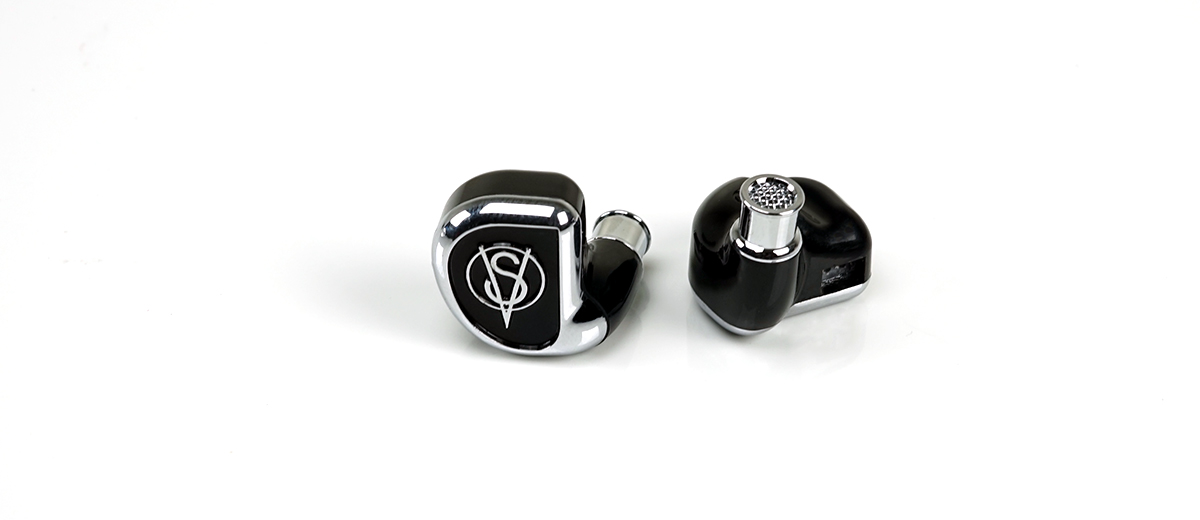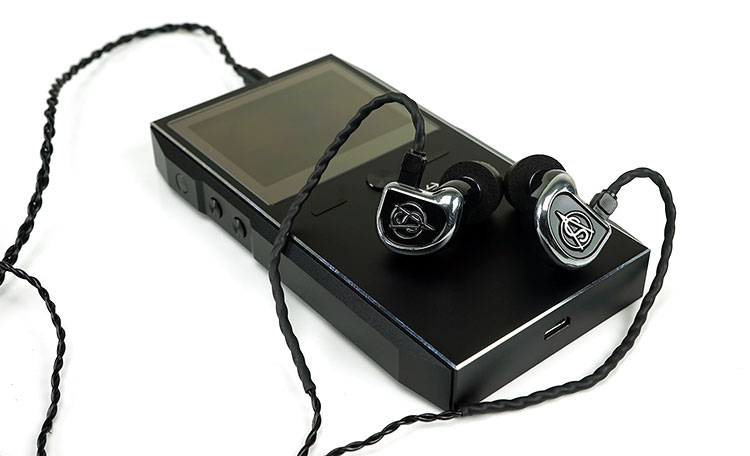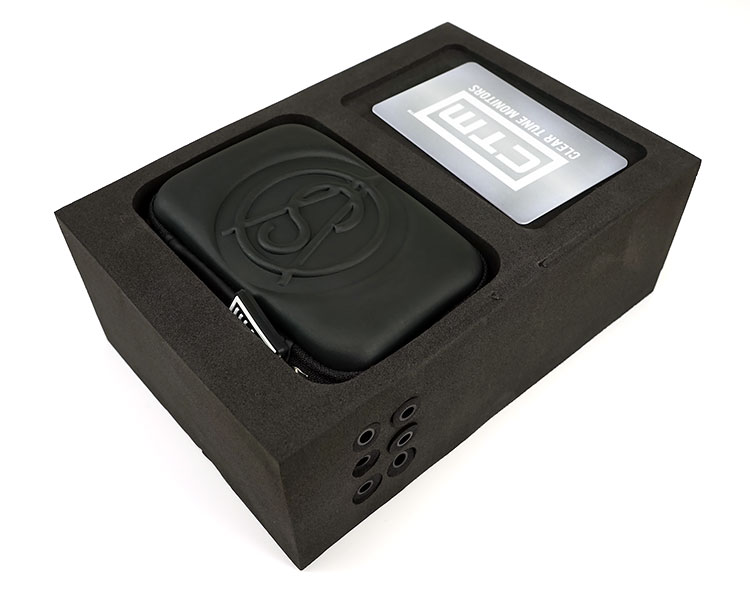Matchability
Efficiency
The VS-4 is rated at 18 ohms and 119dB and it’s pretty clear it is designed to drive well with easy volume control on just about any source, be it a smartphone, DAP or efficient portable amps. This is not a CL1 150-ohm monster, it does not need a high powered or high output power amp to sound good.
Amping
In fact, it was one of the most easily matchable IEM’s I have worked with in terms of voltage demands as well as noise control. Even higher noise floors from portable amps such as the ALO Audio V5 sounded beautifully quiet and very sweet sounding which surprised the heck out of me given its relatively sensitive specs on paper. Amps such as the RX with its aggressive volume levels had more wiggle room with the VS-4 making this an excellent IEM for portable amp matching.
Tonal Preference
Tonally if you are going to pair up with a portable I highly recommend a solid state neutral amp with solid dynamics and resolution. Amps such the ALO Audio RX and the RHA L1 sounded cleaner, more spacious and detailed than the smoother and sweeter V5 tube amp. This IEM scales nicely with a better quality output signal.
You do not need to add more warmth on the VS-4, instead, you want to keep the low-end as tight and clean and the treble smooth and articulated. Both of these amps did an excellent job with the L1 edging ahead with its highly energetic signature though it has very little volume wiggle room compared to the RX which some might prefer to have.
Source Pairings
LG G6
Volume: 40-50 digital steps (75 in total)
Performance
Noise free and no worries on voltage requirements with the LG G6 VS-4 pairing running a good 5-10 steps lower than planar powered iSINE10 and way lower than the DD RHA CL1 which really needs an amp to sound convincing. It is still not as sensitive as say the Andromeda which goes even lower by around 10 steps more on the G6 but it is not quite as fussy with noise as the campfire variant.
Sound
Tonally the G6 is a more of a neutral beast than the V20 with a leaner bass delivery and slightly more mid to treble emphasis which actually provides a nice pacey tight match with the VS-4 with less bass prominence in favor of a balanced to bright presentation.
The top end has plenty of sparkle but that slightly hard edge to the lower treble is more prominent on the G6 than more neutral DAPs. It sounds impressive on some EDM and some heavy rhythmic rock but I find it a little too brittle and lacking in body with other tracks.
FiiO X7 Mark II
Volume: Around 65-75 low gain
Performance (AM3a amp)
The new AM3a has better noise performance than the previous FiiO amp cards and the VS-4 benefits from this by producing a noise free pairing with the new X7 Mark 2.
Sound
Smooth, neutral and refined performance over the G6 with better control on sibilance and a tighter, more defined presentation overall. The G6 might sound cleaner up top but its edgier sounding than the X7 mark 2.
The Mark 2 low-end also sounds more planted and dynamic with the VS-4 without over cooking it. Mids are also a bit more resolving and in particular, vocals lack sibilance compared to the G6. Check out Laura Mvula’s opening low-end rumble of “Overcome” for a really nice example of what this pairing can do
The Bit Opus#2
Volume: 70-80 digital steps
Performance
Beautifully noise free on the Opus#2 and easy on the voltage requirements. There are zero issues in this pairing in terms of driving the VS-4 optimally.
Sound
This is a wonderful pairing, very smooth, clean and clear with pitch perfect control on the treble top end’ sparkle and energy. The relaxed tones of the Opus#2 compliment the VS-4’s exciting contrast really nicely, particularly with jazz and light guitar work.
What seems a bit congested on other sources came alive with the Opus#2. Female vocals, particularly those with an ethereal quality, are sibilant free and very articulate. Instrumental timbre is natural sounding, lacking any nasty overtones or sharpness. You could call it slightly laid back but it seems to just click with the VS-4.
FiiO X5iii
Volume: 60-70 low gain
Performance
Good level of noise control with the X5iii, no detectable hiss and easy enough to drive including more than adequate voltage levels in low gain.
Sound
I half expected this pairing to sound more smoothed over and muddier given the slightly laid back warm tonality of the FiiO X5ii but actually, this didn’t happen.
Treble control on the X5iii was a little muted compared to the Opus#2 and not quite as resolving but it also took a little energy off the top, fattened the low-end nicely without overdoing it and took a softer approach to vocals. It’s not as resolving but it is ideal in terms of musicality and easy listening and a highly recommended mid-fi pairing.
Cayin i5
Volume: 25-35 low gain
Performance
Again a solid pairing with excellent noise control and no background hiss present. Low gain is more than enough for the i5 to drive the VS-4 with a comfortable volume setting of around 25-30 digital steps.
Sound
I found this the most fun pairing of the mid-fi range and more lively and aggressive sounding than the X5iii. The i5 better captures the pitch of the VS-4 with better sub-bass definition and presence, a clean and clear treble without a hint of edginess and decent body right throughout with nothing sounding brittle.
Vocals, though a hairs breath harder sounding than the X5iii, definitely control sibilance really well. High-risk tracks such as Ellie Goulding’s breathy vocals on Burn were kept well under control. This pairing can hit hard, especially with EDM. The potency is good for an all BA setup so I would take this duo for modern genres.
Select Comparisons
Noble Savanna
$499
Performance
The Savanna is around 30 ohms and with a sensitivity rating of well over 110dB, perhaps 115dB or higher. Noble never release the specs but it’s fairly easy to establish that the Savanna is the more efficient of the two in real world tests with the i5 needing about 4-5 steps minimum additional voltage to hit similar volume level as the Noble. The Savanna also will show up a bit of hiss much quicker on higher noise floors such as portable amps than the VS-4.
Sound
We reviewed the Savanna last year and enjoyed the little tweaks Noble put on its sound signature just to give it a little more musicality and natural tone to it timbre than the old Classic 4. However tonally this is a neutral and clean tonal delivery with a little low-end weight and a natural sounding top end without too much lower treble emphasis. Mids are clean and clear, neutral to natural sounding timbre and one of the strong points of this quad BA design.
In comparison, the VS-4 is more dipped in the mids, warmer but more powerful in the lows and has a more energetic and forward lower treble but less post 7k extension and air than the Savanna. In a way, they play off each other with the VS-4 playing more to low-end power and modern dance and the Savanna’s more clinical and resolving mids ideal for rock, indie, acoustics and all things vocal.
Pai Audio MR4
$299
Performance
The MR4 is also a quad-BA IEM though $300 cheaper than the VS-4, but before you go thinking this is a bargain I do request you read a bit more on its sound quality because it does not come close. Comfort and seal though are so very good, it’s a bit bigger than the VS-4 but it has that nice contoured shape of the IT03 and very light in the ear with a good seal even with silicone tips. You will need silicone tips as foams make the sound much too dense. Noise control is good, though not as good as the VS-4 and it is a little easier to drive.
Sound
Tonally the Pai Audio MR4 is overly warm and muddy with a severe post 1k dip which doesn’t see the light of day until around 7-8k. The bass simply overwhelms. The low end is boosted from around 50-300Hz then it starts dropping and stays down to around 7k. The whole presentation struggles for air from around 1k onwards.
This makes everything seem veiled and muted compared to the better low-end control of the VS-4 which has far better extension in both directions and sparkle from around 2k to around 7k.
The VS-4’s V-shaped response is much cleaner and more resolving than the MR4 quad-BA performance with better spacing around the vocals, superior bass/treble contrast, and definition in its low-end.
EQ
EQ the MR4 and its a different ball game though again it is not as resolving as the VS-4 but you can balance out that stock sound with a solid injection of at least 5-6dB on the 1k, 2k, and 4k marker. I would give it actually about 6dB on the 4k marker.
It won’t change the detail levels but you will get a bit more snap and energy in the upper mids and lower treble that it sorely needs. It is more competitive with the tweaks but the VS-4 still has the edge for me.
Sennheiser IE800
$599
Performance
Cry foul but Amazon has it at $599 which makes the Sennheiser TOTL IEM a competitor for your money right now. Technically the fit and likability of the IE800 physically are awful compared to the VS-4. Nothing is detachable, the cable is a right pain and too short, the tips are proprietary and not easily replaced and it has all the seal of a broken plug.
These are well known to Senn fans, I even had a set of custom tips from Snugs made for them to resolve those issues so bear that in mind that the VS-4 is a superior fit and much better sealing IEM.
Noise levels and drivability are surprisingly similar between the two, at least on the i5. Both sat comfortably between 30-35 in low gain with perhaps the IE800 just needing 1-2 steps more but it was much more marginal than I expected.
Sound
Tonally both follow a slightly similar curve up to the mids with a warmish and elevated low-end and a recessed mid-range but the IE800 just dips slightly less and sounds more open and spacious as a result with a more natural and open vocal performance compared to the VS-4 which struggles a bit more for air.
The IE800’s dynamic driver isn’t quite as warm as the low-end of the VS-4 and has a more natural sounding impact with better sub-bass presence. It is not quite as pacy as the VS-4 low end but sounds a little more balanced.
The IE800 also has a good deal more upper extension, detail, and articulation than the VS-4 which trades air for more body and lower treble energy. The IE800 treble is fussy and can sound a little brittle which I didn’t get as much with the VS-4’s treble performance.
Staging wise both lack intimacy with the IE800 sounding the grander and more precise of the two for imaging. You get a great sense of depth with both but the IE800 has the more holographic staging of the two.
Our Verdict
A quad-BA for me is really the sweet spot for mid-fi IEM goodness and the VS-4 adds another very interesting flavor to the ever-fattening audiophile pie. It is not often you get a V-shaped quad BA at this price point. Sure, you get a multitude of hybrid solutions but usually pure quad-BAs aim for balanced, neutral or a mid-centric focus.
I tip my hat off then to Clear Tune Monitors for bucking the trend and coming out with a V-shaped musical and fun sounding IEM that pairs very well indeed with a wide range of sources and modern genres. The coloration won’t be for everyone, vocal lovers, for instance, might choose instead the Savanna, but EDM and R’n’B guys will find the coloration to be just right with plenty of mid-bass impact and weight as well as a solid contrasting treble performance with plenty of sparkle.
It is a competitive world though so at $599 CTM have their work cut out to make a compelling case over and above legends such as the Sennheiser IE800 now trading also at $599 as well as the Quad BA Savanna at $499. Perhaps going for the ‘musical jugular’ rather than creating yet another “audiophile” neutral design might just be the ticket.
Technical Specifications
- Input Sensitivity: 119dB-SPL @ 1mW
- Freq Response: 20 Hz to 16.5 kHz
- Speaker: Quad Balanced Armature
- Impedance: 18 ohm @ 1 kHz
- Noise Isolation: -26dB
- Input Connector: 1/8 (3.5mm)






